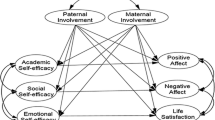Abstract
This study examined the involvement and satisfaction of adolescents with their fathers and mothers. Possible age and sex differences were investigated for three components of involvement: proportion of time spent with fathers and mothers, type of activities engaged in, and degree of satisfaction with those activities. Telephone interviews were used to obtain information about previous day's activities from 61 adolescents in grades 6–12. For each activity, data were obtained on duration, who else was present, and satisfaction. Results indicated that adolescents spent a greater proportion of time in leisure than in work with fathers, and equal time in work and in leisure with mothers. In general, adolescents were as satisfied with activities with their fathers as with their mothers. Adolescents enjoyed working with fathers more than mothers, however. The results demonstrate that activity satisfaction varies as a function of what activities adolescents engage in and who is present.
Similar content being viewed by others
References
Belsky, J. (1979). Mother-father-infant interaction: A naturlistic observational study.Develop. Psychol. 15: 601–607.
Berk, S. F. (1985).The Gender Factory. Plenum, New York.
Christensen, A., and King, C. E. (1982) Telephone survey of daily marital behavior.Behav. Assess. 4: 327–338.
Clark-Stewart, K. A. (1978). And daddy makes three: The father's impact on mother and young child.Child Develop. 49: 466–478.
Cohen, J. A. (1960). A coefficient of agreement for nominal scales.Educa. Psychol. Measure. 20: 37–46.
Csikszentmihalyi, M., and Larson, R. (1984).Being Adolescent. Basic Books, New York.
Douglas, J. W. B., Cooper, J. E., Lawson, A., Cooper, E., McNeil, J., and Alderman, B. (1968). Family interaction and the activities of young children.J. Child Psychol. Psychiatr. 9: 157–176.
Groves, R. M., and Kahn, R. L. (1979).Surveys by Telephone: A National Comparison with Personal Interviews. Academic Press, New York.
Jones, R. R. (1974). Observation by telephone: An economical behavior sampling technique. Oregon Research Institute Technical Report. Eugene, OR.
Kotelchuck, M. (1976). The infant's relationship to the father: Experimental evidence. In Lamb, M. E. (ed.),The Role of the Father in Child Development. Wiley, New York.
Lamb, M. E. (ed.) (1981).The Role of the Father in Child Development (2nd ed.). Wiley, New York.
Lamb, M. E. (in press). The changing roles of fathers. In Lamb, M. E. (ed.),The Father's Role: Applied Perspectives. Wiley, New York.
Lamb, M. E., Pleck, J. H., Charnov, E. L., and Levine, J. A. (in press). A biosocial perspective in paternal behavior and involvement. In Lancaster, J. B., Altmann, J., Rossi, A., and Sherrod, L. R. (eds.),Parenting Across the Life Span: Biosocial Perspectives. Aldine, Chicago.
Larson, R. W. (1983). Adolescents' daily experience with family and friends: Contrasting opportunity systems.J. Marriage Family 45: 739–750.
Mindel, C. H., and Habenstein, R. W. (eds.) (1981).Ethnic Families in America. Elsevier, New York.
Montemayor, R. (1982). The relationship between parent-adolescent conflict and the amount of time adolescents spend alone and with parents and peers.Child Develop. 53: 1512–1519.
Parke, R. D., and Tinsley, B. R. (1981). The father's role in infancy: Determinants of involvement in caregiving and play. In Lamb, M. E. (ed.),The Role of the Father in Child Development (2nd ed.). Wiley, New York.
Pleck, J. H. (1983). Husbands' paid work and family roles: Current research issues. In Lopata, H., and Pleck, J. H. (eds.),Research in the Interweave of Social Roles: Vol. 3. Jobs and Families. JAI Press, Greenwich, CT.
Russell, G. (1983).The Changing Role of Fathers? University of Queensland Press, St. Lucia, Queensland.
Stone, P. J. (1972). Child care in twelve countries. In Szalai, A. (ed.),The Use of Time. Mouton, The Hague.
Weissman-Frisch, N., Crowell, F. A., Bellamy, G. T., and Bostwick, D. (1983). A telephone interview technique for assessing living environments and lifestyles of retarded adults in community residential facilities.Behav. Assess. 5: 219–230.
Zeigler, M. (1980).The father's influence on his school-age child's academic performance and cognitive development. Unpublished doctoral dissertation, University of Michigan.
Author information
Authors and Affiliations
Additional information
Received his Ph.D. from Michigan State University. Major research interests are in parent-adolescent relations.
Received his Ph.D. from Georgia State University. Major research interests are in early peer relations and mother-child interactions.
Rights and permissions
About this article
Cite this article
Montemayor, R., Brownlee, J.R. Fathers, mothers, and adolescents: Gender-based differences in parental roles during adolescence. J Youth Adolescence 16, 281–291 (1987). https://doi.org/10.1007/BF02139095
Issue Date:
DOI: https://doi.org/10.1007/BF02139095




